Gallery
- Military Medical Corps
- Military Legal Corps
- Military Comptroller Corps
- Military Band Corps
The Common Corps of the Armed Forces are Spanish military corps that are shared by all the branches of the Spanish Armed Forces providing specific professional expertise. The Common Corps are divided into four units; the Military Legal Corps (legal assistance), the Military Comptroller Corps (audit and accountability), the Military Health Corps (medical personnel) and the Military Bands Corps (military bands). [1] Currently, 3,998 Officers and WOs make up the Common Corps. [2] The educational centres of the Common Corps are part of the Central Defence Academy.
Until the 1980s each of the branches of the Armed Forces had specific corps to undertake the tasks currently taken by the Common Corps. Due to operational reasons these corps were merged into the common corps that depend on the undersecretariat of the Ministry of Defence. In 1985 the Comptroller Corps were merged, in 1988 the Legal Corps were merged, and in 1989 the Medical and Bands Corps were merged.
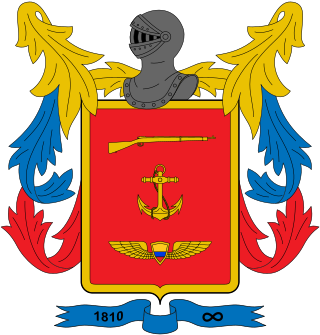
The Military Forces of Colombia are the unified armed forces of the Republic of Colombia. They consist of the Colombian Army, the Colombian Navy and the Colombian Aerospace Force. The National Police of Colombia, although technically not part of the military, is controlled and administered by the Ministry of National Defence, and national conscription also includes service in the National Police, thus making it a de facto gendarmerie and a branch of the military. The President of Colombia is the military's commander in chief, and helps formulate defense policy through the Ministry of National Defence, which is in charge of day-to-day operations.

A military band is a group of personnel that performs musical duties for military functions, usually for the armed forces. A typical military band consists mostly of wind and percussion instruments. The conductor of a band commonly bears the title of bandmaster or music director. Ottoman military bands are thought to be the oldest variety of military marching bands in the world, dating from the 13th century.

The Civil Guard is one of the two national law enforcement agencies of Spain. As a national gendarmerie, it is military in nature and is responsible for civil policing under the authority of both the Ministry of the Interior and the Ministry of Defence. The role of the Ministry of Defence is limited except in times of war when the Ministry has exclusive authority. The corps is colloquially known as the benemérita. In annual surveys, it generally ranks as the national institution most valued by Spaniards, closely followed by other law enforcement agencies and the armed forces.

The Marine Infantry is the naval infantry branch of the Spanish Navy responsible for conducting amphibious warfare. Fully integrated into the Spanish Navy's structure, the branch's history dates back to 1537 when Charles V, Holy Roman Emperor formed the Compañías Viejas del Mar de Nápoles, making it the oldest marine unit in existence.
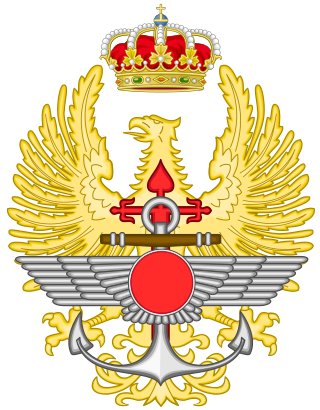
The Spanish Armed Forces are in charge of guaranteeing the sovereignty and independence of the Kingdom of Spain, defending its territorial integrity and the constitutional order, according to the functions entrusted to them by the Constitution of 1978. They are composed of: the Army, the Air and Space Force, the Navy, the Royal Guard, and the Military Emergencies Unit, as well as the so-called Common Corps.

The Ministry of Defence is the government ministry responsible for safeguarding national security on land, sea and air. It exercises command over the Peruvian Armed Forces composed of the Army, the Navy and the Air Force. As of 13 February 2024, the current defence minister is Walter Astudillo.

The Royal Guard is an independent regiment of the Spanish Armed Forces that is dedicated to the protection of the King of Spain and members of the Spanish royal family. It currently has a strength of 1,500 troops. While the Guard participates in parades and other ceremonial events, it is a fully functional combat unit. Its members are recruited from the ranks of all three branches of the Spanish Armed Forces and receive the same combat training as regular soldiers.
Law enforcement in Spain is carried out by numerous organizations, not all of which operate in the same areas.

The Peruvian Naval Aviation is the air branch of the Peruvian Navy. It was originally formed in 1919 as the Naval Aviators Corps but was merged in 1932 with the Peruvian Army Aviation. The service was recreated under its current name on July 3, 1963. It is currently made up of three operational squadrons and the Naval Aviation School. The squadrons are distributed among three bases: Lima-Callao, which is part of Lima's Jorge Chávez International Airport, San Juan de Marcona and Pucallpa. About 800 personnel comprise Peruvian Naval Aviation.
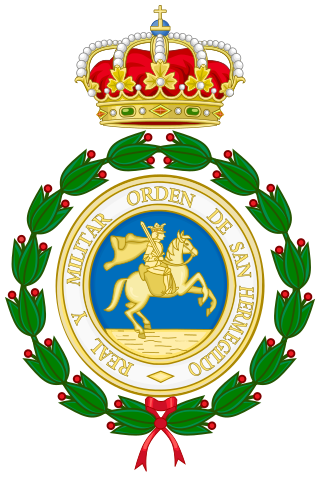
The Royal and Military Order of Saint Hermenegild is both a general military honor and a legion created by King Ferdinand VII of Spain on 28 November 1814.

The unification of the Canadian Armed Forces took place on 1 February 1968, when the Royal Canadian Navy, Canadian Army, and Royal Canadian Air Force were merged to form the Canadian Armed Forces.

The Ministry of Defence (MINISDEF) is the department of the Government of Spain responsible for planning, developing and carrying out the general guidelines of the Government about the defence policy and the managing of the military administration. It is the administrative and executive body of the Spanish Armed Forces.

The Chief of the Defence Staff is the highest-ranking military officer in the Spanish Armed Forces and is the principal military advisor to the Prime Minister, the Minister of Defence, the National Defence Council and the National Security Council. It is the fourth military authority of the country after the Monarch, the Prime Minister and the Minister of Defence because the Secretary of State for Defence and the Under-Secretary of Defence do not have military authority.
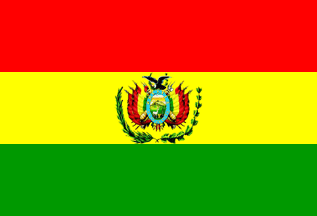
The Armed Forces of Bolivia has four main branches: Army, Navy, Air Force and the National Police Force. Each of the four branches has a similar structure, each having four pay grades: non-commissioned officers, senior non-commissioned officers, commissioned officers and general staff. However, the SNCO roles vary depending on the branch; some of these hold specialisations.
General of the Army(Spanish: General de Ejército), also called Army General, is a four-star general officer and the second highest possible rank in the Spanish Army. A General of the Army ranks immediately above a Lieutenant general and is equivalent to an Admiral General and a General of the Air. There is no equivalent in the Civil Guard or in the Spanish Navy Marines; in both cases the top rank is Lieutenant General.
General of the Air also called Air General, is a general officer and the second highest possible rank in the Spanish Air and Space Force. A General of the Air ranks immediately above a lieutenant general and is equivalent to a general of the army and an admiral general. There is not equivalent in the Civil Guard or in the Spanish Navy Marines; in both cases the top rank is Lieutenant general.
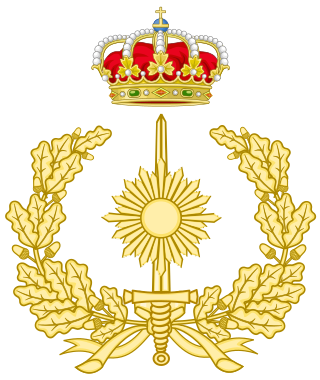
The Office of the Comptroller General of the Defence is a department of the Ministry of Defence of Spain that exercises the internal audit of the economic and financial management of the Ministry and of the public agencies dependent on it. Likewise, it is responsible for acting as the military notary in the form and conditions established by the laws and for advising in matters of its competence to the superior and directive departments of the Ministry. The Office is integrated in the Undersecretariat of Defence but it reports to the Comptroller General of the State.

The Central Defence Academy is a military training center of the Common Corps of the Spanish Armed Forces located in the city of Carabanchel, Madrid. The center is responsible for providing specialization training to officers and non-commissioned officers in the Spanish Armed Forces and its service branches. The ACD consists of affiliate schools which specialize in areas of speciality in the Spanish Army It was created in response to the provisions of the Royal Decree of King Felipe VI on 20 June 2014. It is regulated by the Order of the Ministry of Defense (MINISDEF) on 9 September 2015. The ACD reports directly to the General Directorate of Recruitment and Military Education of the Ministry of Defense. The director of the academy is an officer with the rank of general officer who also serves as the assistant director general of the Military Education Service
The Chief of the Joint Defence Staff (JEMACON) is a high-ranking military officer. The JEMACON is the closest assistant and advisor to the Chief of the Defence Staff and it is appointed by the Monarch at the request of the Minister of Defence.
For the historic Rurales of Mexico see: Rurales and For other Rurales types forces see: Rurales (disambiguation)